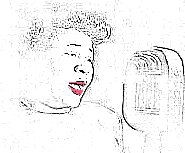
Example 6: Vocal Stylings

In the late 1950s, jazz vocalist Ella Fitzgerald made classic recordings of the songs of the American composer Irving Berlin. The critic Stanley Green made special note of Ms. Fitzgerald's interpretation of the song "Blue Skies":
"There is the inspired touch of having the acceleration quicken on the line 'Never saw the sun shining so bright.' "
Close listening confirms that Ms. Fitzgerald's superbly controlled voice is up to something on this line. But... "having the acceleration quicken"?
We can measure a singer's progress through a song by keeping track of the number of musical "measures" m that have been sung after some time t :

The function m(t) gives a kind of "distance travelled" through the song.
The speed at which a song is sung, measured by the rate of change
Vocal stylings often involve a shift in tempo from slow to quick, or vice versa, to change the feeling or emphasize a line. Tempo changes – musical accelerations – unfold at a rate measured by
Quickening the acceleration, however, is another matter. This would involve a third rate of change,
One is hard pressed to imagine it, let alone hear it, and even someone as gifted as Ms. Fitzgerald would have been hard pressed to sing it.
|
|
|
| Back to Contents | |